#lon chaney senior
Photo

4 notes
·
View notes
Text
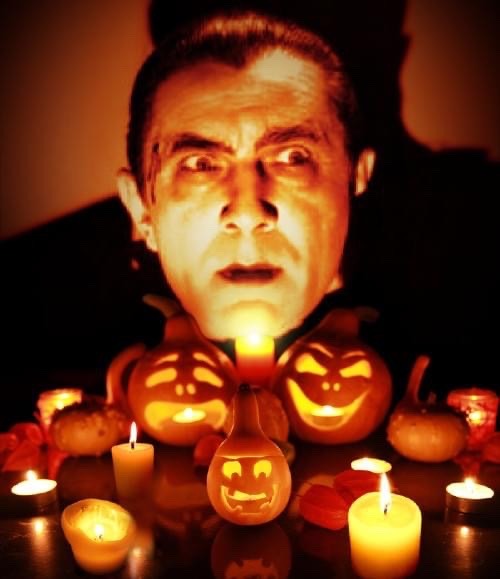
Happy Halloween!
Bela Lugosi King of Fright
In arcane shadows of the silver screen
These iconic monumental Masters of the macabre will make you shudder and scream
Lon Chaney Senior the phantasmal man of a thousand faces
is one of many to which the screen he graces
Boris Karloff is a celluloid monarch as horror fans we all worship and hail
Lon Chaney Jr.'s Wolfman leaves behind a bloody, gruesome homicidal trail
Vincent Price laughs with a ghastly glare
Basil Rathbone creeps through the midnight air
While Peter Lorre chooses his victims with keen and sadistic care
John Carradine stares with mesmerizing evil stone-cold eyes
Dwight Frye's Renfield eats plump juicy spiders and flies
George Zucco experiments upon the living dead
Lionel Atwill ogles gleeful with mad bloodshot burning eyes of red
Charles Laughton's Dr. Moreau is blasphemously deranged as one can be
Excellent are Horror Greats such as Peter Cushing and Christopher Lee.
The deformed Rondo Hatton will leave you with an uncanny chill
Claude Rains' performances are phenomenal and forevermore thrill
Gale Sondergaard, the dark beauty will rob you with her draconian heart
These legends are immortalized in cinematic history and will never be forgotten nor will their legends that haunt us ever depart...
In the saturnine shadowy bowers of our hearts now comes the imperial looming Master of this ghastly Hollywood regime,
Hollywood's Prince of Darkness whose dominion reigns ever supreme,
In the terror throughout the sequential lexicons of celluloid time,
the epitome of horror he truly defined,
he has enchanted and seductively made the ensorcelled souls of so very many moves to heart-quake and scream,
He resides lurking in the lugubrious chambers our hearts, souls, nightmares and beautiful dreams, and captivates us all with his vampiric kiss in the mysterious night and while drunken in the esoteric bath of mordacious moonbeams
Hail Bela Lugosi Father to all the lost howling children of the night
Bela Lugosi is King of horror who can still enthrall
He will mesmerize you entirely and make your skin crawl
So, remember on this frightful Halloween night, who truly is the King of fright
Bela (Dracula) Lugosi who stalks on the screen and the forsaken eternal midnight.
- Christopher R. Gauthier
#halloween#classic horror#classic monsters#dracula#frankenstein#dwight frye#boris karloff#vincent price#bela lugosi#lon chaney#basil rathbone
13 notes
·
View notes
Text
Where Wolf?

( "Werewolf" by San Diego Shooter is licensed under CC BY-NC-ND 2.0. )
You don't think this should be that difficult, but apparently it is. All you want—you tell people as you travel the globe—is to find a werewolf, capture it, prove its existence and amaze the world. You don't know why people find this so confusing. It shouldn't be that difficult to understand. You're looking for a person who, every full moon, turns into a giant wolf beast that tears across the countryside, causing mayhem and generally wrecking up the place. You don't even need a specific werewolf. Any werewolf, really, would be enough. But no. Every time—EVERY EVERY.SINGLE.TIME—you think maybe this is it, you've finally found a werewolf, you find, no, it's not, and whoever gave you whatever lead you followed, once again, didn't understand you.
The first time you think, okay, maybe you weren't being clear enough. That was the time you were in northern England, Durham County to be precise, tracking the werewolf by the river bank, right where the villagers had said it would be. In the light of the full moon, you set a snare and place inside it a big, juicy steak. Before long, you hear it spring and your heart soars. But what you find is not some nine foot tall shag carpet of death, but a regular wolf, struggling in your trap. The villagers cheer and say you did it, you caught the werewolf! You say you didn't, that's just a regular wolf, but the villagers point out it was right by the banks of the River Were. Therefore: Were Wolf. Later on, biologists are amazed that wolves are still around northern England, as everyone thought they'd been extinct since about the 18th century. The discovery of these wild wolves, after all this time, well it's practically a miracle. But you don't care. It's not the werewolf you were thinking of.
The second time you decide to be much more specific in what it was you were seeking. This time you're in a mall, one of the last in America, and you tell passersby that you've heard there's a giant wolf man in this area—not a regular wolf, you continually stress—and ask whether they've seen anything like that here. For the first few hours, you find nothing, no one having seen anything unusual save the presence of a thriving mall in an area with very little population density. This is likely because it is daytime. But eventually night falls and the moon rises. Now you ask and people say, yes, it's at the other end of the mall and you need to hurry! You run, pushing through the inexplicably dense crowds and even knocking over a few senior citizens, to find there is indeed a giant wolf man. It's no costume or robot, it's the real deal. The beast stands nine feet tall, with glowing red eyes and razor sharp teeth and it has all sorts of deals and discounts for YOU! Only the Warewolf, you find out, offers quality appliances and home goods for affordable prices but only on a full moon. Otherwise, you find, he is a mild mannered insurance adjuster. Despite going home with a new microwave, which cost only half what it does at other stores, you are not impressed. You were not looking for a wolf creature hawking wares. You were looking for a werewolf. How hard is this to understand?

( "WOLF MAN, THE - Promo - 1195-29AD - Lon Chaney - (Monster) - 1941 - Cropped for eyes" by monstersforsale is marked with Public Domain Mark 1.0. )
The third time you think, okay, you're going to be VERY clear. You hold a picture of celebrated 1940s actor Lon Chaney Jr. in perhaps his most famous role The Wolf Man, then ask: have you seen a werewolf? People's eyes flash with recognition and say they have indeed seen someone like that before: in Paris! So, to the City of Lights you go, where you get closer and closer to your target. A woman leaning against a doorframe smoking a cigarette says yes, yes, she has seen this, how you say, wolf person. She gestures in the air with her Gauloise and says it can be found at the Avenue Montaigne. You ride there on a small scooter, your black and white striped scarf fluttering behind you. By the time you reach your destination, there is already quite a scene. You push your way through the dense crowd of onlookers to see what everyone is gawking at. It's a wolf person who highly resembles Lon Chaney Jr. except much bigger. And they are wearing an an over-the-shoulder Lanvin piece with Louis Vuitton shoes, a Givenchy bag, and a Hermes leather jacket. The wolf wears it all with style so intense it intimidates you immediately. You find yourself unable to appreciate the outfit fully.
Similar sets of circumstances lead to the wolf who doubles as a low-headed dam that can regulate river flow and elevation (the weir wolf); the wolf who is, in actuality, ten wolves linked together in a psychic hive mind (the we're wolf); the wolf that makes quite a bit of pocket money selling Tupperware (the 'Ware wolf, though this one you feel is kind of a stretch), and the wolf that exists in the form of software specifically related to wolves (wolfware).
The world is, quite frankly, amazed at all your discoveries. But you're not. You never found what you were looking for. The werewolf, the real actual true werewolf, continues to elude you. You feel more and more lost by the day.
And then, during a full moon, you find yourself transformed. Your hair grows, your flesh stretches and warps, and your teeth grow into sharp knife-like fangs. But you're still completely lost. With growing horror you realize that so many days of asking where is this wolf, where do I find this wolf, where do I capture this wolf has turned you into something else. Something inhuman. Something that's still not a werewolf. No. You realize, as you wander around, no idea where you're going, you are now... The Wherewolf.
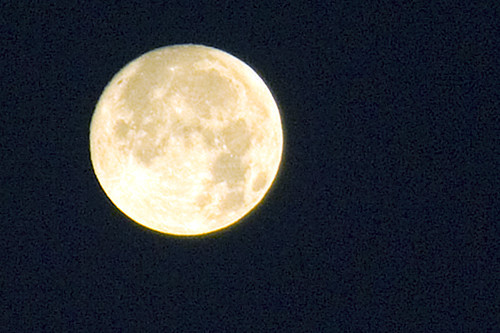
( "Wolf's Moon" by Anindo Ghosh is licensed under CC BY 2.0. )
9 notes
·
View notes
Photo

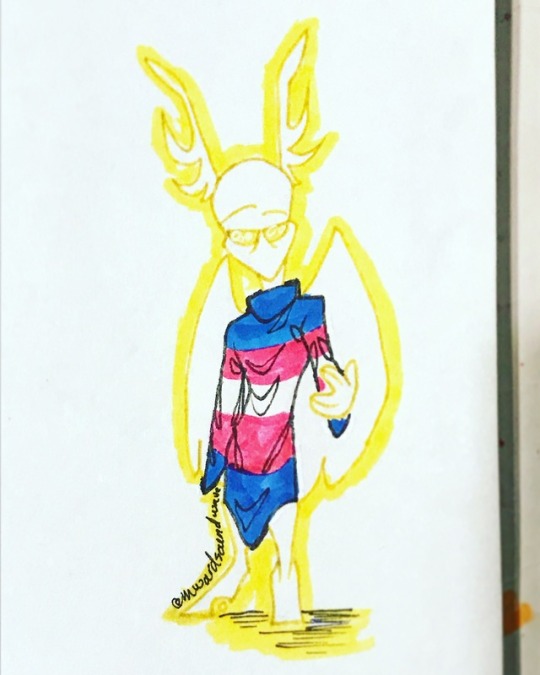
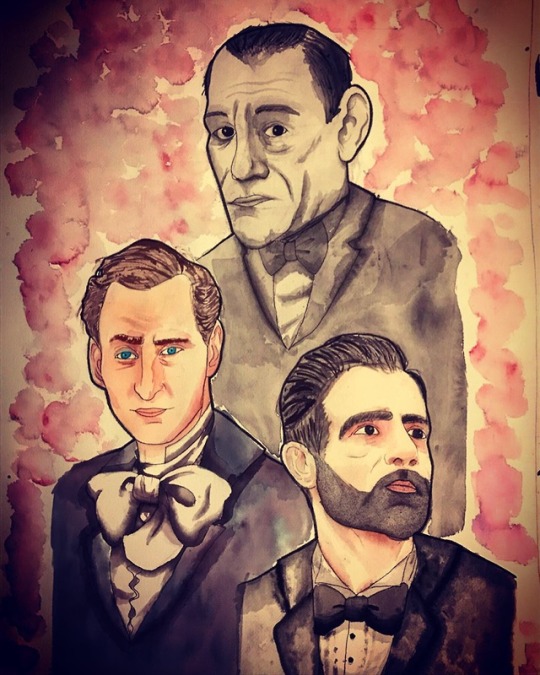


Some stuff from Insta
#demon oc#gay#transgender#angel oc#devil shenanigans os#addison the highlight#oakland the gatekeeper#kane the reaper#hidden in the sandau#ezra the sawbone#hitchhiking ghosts#The Hitchhiking Ghosts#Haunted Mansion#haunted mansion au#Phantom of the Opera#The Phantom of the Opera#Lon Chaney#lon chaney senior#ramin karmiloo#charles dance erik#charles dance#watercolor#prismacolor#mwardsoundwave art#the graveyard of dead fire and wind
32 notes
·
View notes
Photo

NECA has formally detailed plans for its line of Universal Monsters ultimate action figures. As previously announced, a black-and-white Frankenstein will kick off the collection in July, with a color version to follow later.
Subsequent figures set for release in 2021 include Lon Chaney Jr. as The Wolf Man, Boris Karloff as The Mummy, and Bela Lugosi as Dracula. NECA is working closely with Universal Brand Development, Lugosi LLC, and Chaney Entertainment.
Each fully-articulated 7" scale toy includes alternate heads, hands, and accessories. They’re packaged in a window box with opening flap. Get your first look at The Mummy above and the Wolf Man’s accessories below.
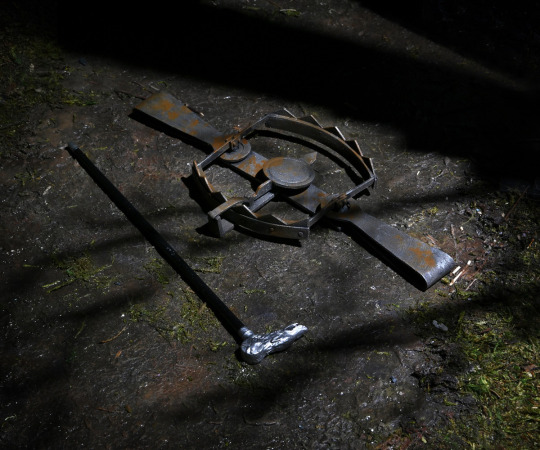
NECA vice president and senior director of product development Randy Falk had the following to say:
As a lifelong fan of Universal Monsters, this is a dream come true. I’ve been collecting Universal Monsters toys since I was a kid. This line aims to create something hyper-realistic and ultra-detailed for people like me who grew up watching these amazing movies and have always longed for definitive versions.
#universal monsters#the mummy#the wolf man#dracula#frankenstein#neca#toy#gift#boris karloff#lon chaney#lon chaney jr.#bela lugosi#horror#classic horror#mummy#wolf man
41 notes
·
View notes
Photo
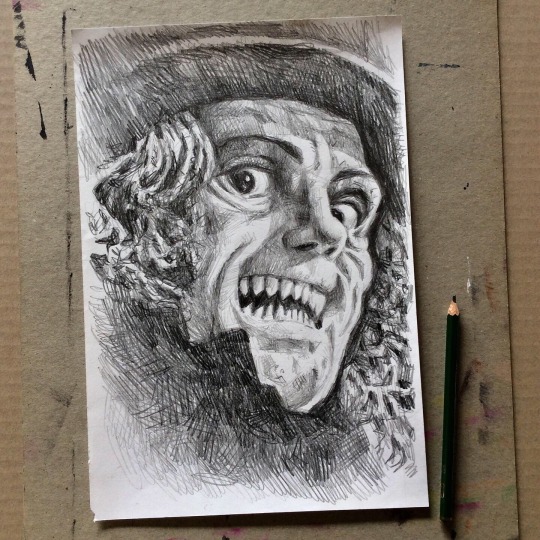
Pencil drawing of Lon Chaney Senior in ‘London After Midnight’ (1927) One of the many silent movies lost in the MGM movie vault fire of 1965
#Lon Chaney#horror#horror fan art#pencil drawing#drawing#silentmovie#movies#fantasy art#artwork#Fanart#fantasy#Monster
2 notes
·
View notes
Text
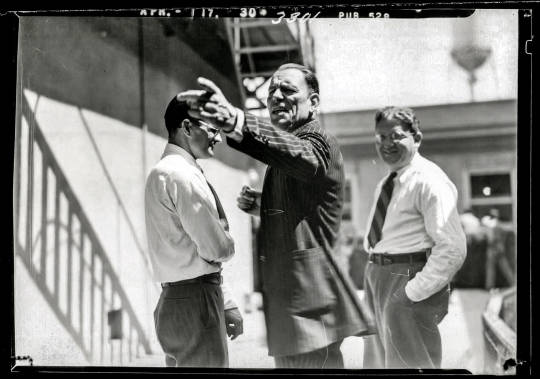
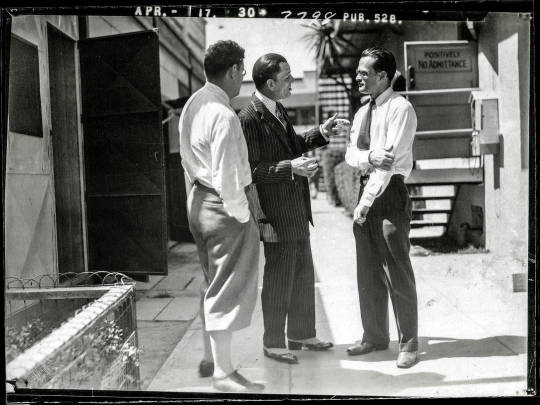
2 Very rare Lon Chaney Senior pictures.
The tops of the frames are dated. APRIL 17, 1930. He died August 26, 1930, aged 47. Another heavy smoker.
Approximately 102 of the 157 films made by Chaney are currently classified as lost films. A number of others exist only in extremely truncated form or suffer severe decomposition.
WIKIPEDIA:
During the filming of 'Thunder', in the winter of 1929, Chaney developed pneumonia. In late 1929, he was diagnosed with bronchial lung cancer. This was exacerbated when artificial snow lodged in his throat during filming and caused a serious infection. Despite aggressive treatment, his condition gradually worsened, and he died of a throat hemorrhage on August 26, 1930, in Los Angeles, California.
His funeral was held on August 28 in Glendale, California. Honorary pallbearers included Paul Bern, Hunt Stromberg, Irving Thalberg, Louis B. Mayer, Lionel Barrymore, Wallace Beery, Tod Browning, Lew Cody, and Ramon Novarro. The U.S. Marine Corps provided a chaplain and Honor Guard for his funeral. While his funeral was being conducted, all MGM studios and offices observed two minutes of silence.
Chaney was interred at Forest Lawn Memorial Park Cemetery in Glendale, next to the crypt of his father. His wife Hazel was interred there upon her death in 1933. In accordance with his will, Chaney's crypt has remained unmarked.
3 notes
·
View notes
Text
how come aint nobody talkin about my spooky dad Mister Lon Chaney Senior?? this is a personal attack
#i love my spooky dad#we as a collective people need to celebrate mister lon chaney#like i know he lived like 100 years ago but like bruh#he's cool as fuck#i Need to see more lon chaney on my dash#lon chaney sr#spooky dad
3 notes
·
View notes
Text
youtube
Time for your daily dose of the Damned...
Boy is my face red. I just realized that I had my YouTube playlist settings on private. For some, if not most of the videos I posted on here.
Talk about a senior moment *damn it*
I fixed it so we should be good. I think.
Today's video is a favorite of mine and not just bc of the ladies parading the stage in their knickers with their lovely bums...nor is it bc of the guy in drag who looks alot like Amy Winehouse.
It could be said that Screaming Lord Sutch was a precursor of the Damned. At the very least, influential.
One of the first Damned CD's I bought (called Eternally Damned -a greatest hits comp) I believe mentioned them playing a few gigs together. Not positive about the last part but I will say if you listen to Lord Sutch's vocals they pay an eerie resemblance to those of Dave Vanian.
There's a great YouTube vid of SLS scaring the piss out of little girls in the 60's as he lurches around stage, dressed as Lon Chaney from the movie London after Midnight, crooning a tune called Jack the Ripper.
I would have posted that vid but in the end (yes the pun was intentional) it was the women's posterior that swayed my vote.
#the damned#dave vanian#screaminglordsutch#shock rock#70s rock#amy winehouse#writers blog#alice cooper
3 notes
·
View notes
Text
Cowboys And Cavemen
This one’s gonna meander, but it’s about
cavemen and cowboys and dinosaurs,
so some of you may wanna stick around…
. . .
Recently watched the colorized version of One Million B.C. with Victor mature, Carole Landis, and Lon Chaney Jr.
I remember frequently watching the original black & white version of this as a kid; it popped up on local Early Shows a lot primarily because it could be chopped down to fit an hour’s running time without losing too much of the story (Early Shows were afternoon movies with a local host that typically ran only 90 minutes from 4:30-6pm; with commercials and host segments there wasn’t much room for uncut films and as a result they featured a lot of B-movies with 65 minute running times, or else cut out sequences from longer films not germane to the plot).
The colorized version surprised me in a couple of ways.
First, I’d forgotten just how well done One Million B.C. is in basic film making terms: Once past the opening scene, in which an archeologist explains some cave drawings to a group of mountaineers who then imagine themselves in prehistoric times, there’s no recognizable dialog; the film is told in purely visual terms.
Second, the colorization was incredibly sloppy: There’s a lot of weird blue artifacting going on that lays a strange mist-like quality over several scenes, and in several places the colorists inexplicably either colored the actors’ bare legs blue or else overlooked the mistake in the final color correction.
Third, the sloppy colorization doesn’t matter: If anything, it adds to the weird dream-like quality of the film. As an attempt to realistically recreate the prehistoric past, it’s gawdawful; taken as the imaginings of an average contemporary 1940s person with no real knowledge of prehistoric times (viz the prolog), and it’s pretty entertaining.
Technically the movie is a mixed bag. The special effects are pretty seamless (yeah, you can tell when something is a rear screen shot, but then again rear screen shots in every film of that era were obvious)). A travelling matte shot of a hapless cavewoman buried under a flood of lava is particularly well done and as amazing today as it was then (though the colorists dropped the ball and didn’t tint it a vivid red or orange in the colorized version).
There’s a lot of monsters, but they range from well done to just plaine…well…
The best are a woolly mammoth (i.e., an elephant in shaggy fur costume) and a baby triceratops (a large pig in costume) that really seem to capture the essence pf those creatures.
The worst is a guy in an allosaurus suit who kinda just shuffles along like a grandparent going to the bathroom, and in the middle are various lizards dressed up with fins and horns.
The lizards bother me more and more over the years. At first it was because they were disappointing -- they don’t look like dinosaurs, dammit, but like lizards with fins and horns glued on -- but now it’s because I realize they were goaded by their handlers into fights and reactions shots.
That’s plain ol’ animal cruelty, even if they are reptiles and not mammals.
There’s an armadillo and a koala-like animal that appear thousands of times their normal size. The koala-like critter (sorry, but I don’t know what it actually is) is passable as a giant cave bear or sloth, but the armadillo is just an armadillo (there was something about armadillos that 1930s audience found creepy; they’re waddling all over the Count’s hiding place in the original Dracula).
One Million B.C. was produced by Hal Roach and Hal Roach Jr. The senior Roach goes all the way back to the silent era, so this was not a huge stretch for him.
Originally D.W. Griffith was to direct the film, but while he did a lot of pre-production work including screen and wardrobe tests, he either dropped out or was replaced on the eve of production. (Reportedly he wanted the cave tribes to speak recognizable English and left when Roach refused.)
The special effects wound up in a ton of movies and TV shows over the ensuing decades; modern audiences are more familiar with the film through 1950s sci-fi than its original version.
All else aside, the picture is carried by stars Victor Mature and Carole Landis. Ms Landis in particular is a spunky, charming cave gal with a blonde-fro and while Mature would never be an Oscar contender, he at least has the physicality and screen presence to get his character across.
The scene where he thinks Landis has died in a volcanic eruption may be corny, but you can feel his character’s grief.
. . .
A quarter of a century later it was remade as One Million Years B.C. with John Richardson in the Victor mature role and Raquel Welch in the Landis role.
No disrespect to Welch, who by all accounts is a nice person, but she never showed one iota the acting chops of Carole Landis. Welch is beautiful, and as a generic pin-up model cast as a film’s “sexy lamp” (look it up), she presented appealing eye-candy. She appeared in one good sci-fi film (Fantastic Voyage), one campy monster movie (i.e., One Million Years B.C.), two incredibly campy WTF-were-they-thinking movies (The Magic Christian and Myra Breckenridge), and a host of instantly forgettable spy films and Westerns. The best movies she appeared in were Fuzz, based on the 87th Precinct novels by Ed McBain (a.k.a. Evan Hunter nee Salvatore Lombino), where she did an acceptable supporting turn as a police detective, and Kansas City Bomber, a roller derby movie that many consider her best role.
Landis never enjoyed the same level of fame (or notoriety, depending on your POV) that Welch did, but holy cow, could the gal act. It’s a pity Hollywood is crowded with talented, beautiful people because she certainly deserved a bigger career capstone than One Million B.C..
Welch’s personal life certainly proved less traumatic than Landis’, however. When actor Rex Harrison broken off his affair with her rather than divorce his wife, Landis committed suicide.
The scandal exiled Harrison temporarily back to England. A few years later One Million B.C. and Landis’ other films started playing on television.
Who knows what opportunities may have opened for her in that medium?
. . .
The original One Million B.C. is vastly superior in all areas but one (well, two -- mustn’t leave out the catfight between Welch and Martine Beswick): Ray Harryhausen’s stop motion dinosaurs
Mind you, most of the dino scenes in One Million Years B.C. are underwhelming. To stretch the budget the producers used close ups of spiders and an iguana to simulate giant monsters, a brontosaurus does a walk through in one scene and never appears again, and the first big dino moment has cave gals poking sharp sticks at a big sea turtle.
On the other hand, the remaining trio of dino scenes are the aces and vastly superior to their corresponding scenes in One Million B.C.. The latter film’s allosaur attack is one of the best dino scenes ever animated, and the ceratosaurus vs triceratops battle followed by the pteranodon grabbing Welch are almost as good.
Both versions of the film had an interesting influence on films that followed. One Million Years B.C. was followed by a host of prehistoric films, most of which existed only to cast voluptuous actresses in fur bikinis although When Dinosaurs Ruled The Earth, a direct follow-up, offered more monsters and a better story.
While One Million B.C. wasn’t the first film to sub real life lizards for dinos, it certainly told budget conscious producers that such substitutions were okay.
The 1959 version of Journey To The Center Of The Earth cast iguanas with glued on fins as dimetrodons, and for once the impersonation proved successful as the two species do bear certain similarities.
Producer Irwin Allen (he of Lost In Space and Towering Inferno fame) hired Willis O;Brien (the animator behind the original King Kong) and his then assistant Ray Harryhausen to do accurate-for-the-era stop motion dinosaurs for The Animal World documentary but apparently frustrated by the time it took to get results opted for lizards in his version of The Lost World (which, ironically, O’Brien worked on in a non-animation capacity despite having done the original silent version of the film with stop motion dinosaurs).
I saw Allen’s Lost World as a little boy and felt grossly disappointed by the obvious lizards, especially since the script identified them as belong to specific dinosaur species when they quite clearly didn’t (had the script said they evolved from such creatures, the way the most recent version of King Kong did, it would have been less egregious).
Allen’s lizards popped up in several TV shows he did, most notably the TV version of Voyage To The Bottom Of The Sea. That show’s co-star David Hedison played a supporting role in The Lost World so once a season they found some excuse to get him out of his Navy uniform and into a safari jacket in order to match footage with stock shots from the movie.
The Animal World wasn’t the first time O’Brien and Harryhausen worked together, and Harryhausen followed up One Million Years B.C. with The Valley Of Gwangi, an O’Brien project that the older effects artist never got off the ground.
. . .
Let’s back up a bit to discuss “O’Bie” (as his fans refer to him).
O’Brien was a former cowboy-turned-cartoonist around the early 20th century who became interested in animation.
Movies were in their infancy then, and O’Bie shot a short test reel of two clay boxers duking it out.
This got him financing to do a series of short films ala The Flintstones with titles like Rural Delivery, One Million B.C. (the titles were often longer than the films).
These shorts featured cartoony puppets, no actual actors. O’Bie followed it up with The Ghost Of Slumber Mountain which was the first time dinosaurs were animated in an attempt to make them look real, and that was followed by The Lost World in which O’Bie combined live action with special effects, climaxing the film with a brontosaurus running amok in London.
O’Bie wanted to follow it up with a film called Creation but that got deep sixed. However, producer Merian C. Cooper saw O’Bie’s test footage for Creation and hired him to do the effects for the legendary King Kong.
While O’Bie followed that success with the quickie Son Of Kong he never got to work on a dinosaur film of such scope again.
War Eagles (a lost-civilization-with-dinos story) was supposed to have been a big follow up epic, but the Depression and the growing threat of WWII caused it to be cancelled in pre-production.
During the 1940s O’Bie pitched a number of stories to studios involving dinosaurs or other monsters encountering cowboys, one of which was Gwangi (he also pitched King Kong vs Frankenstein which eventually got made as King Kong vs Godzilla using two guys in rubber suits, not his beloved stop motion effects).
Gwangi had cowboys discovering a lost canyon inhabited by dinosaurs, chief of which being Gwangi, an allosaurus. O’Bie never got Gwangi off the ground but decades later Harryhausen did with Valley Of Gwangi.
. . .
I never cared for Valley Of Gwangi and much preferred One Million Years B.C. over it (and, no, not because of Ms Welch).
Growing up in the 1950s and early 1960s, I enjoyed cowboys as much as dinosaurs.
I’ve posted elsewhere how my interest in dinosaurs led me to dinosaur movies which led to monster movies which led to science fiction movies which led to literary science fiction which led to science fiction fandom which led to my writing career, but my genre of choice before age 10 was Westerns.
As others point out, most Westerns are actually crime stories, what with bandits robbing stagecoaches and banks, rustlers making off with cattle, etc. The climax usually involves a lawman (or a vigilante who carries the weight of the law) confronting the evil doers and bringing them to justice.
Sometimes these vigilantes wore masks (Zorro and the Lone Ranger). Sometimes those they pursued wore masks, and sometimes those masked villains pretended to be ghosts or phantoms.
They weren’t, and were invariably exposed as frauds.
Westerns based themselves in a rational world.
Other times a criminal in a Western would be after some invention that could bring either a great boon (say an energy source) or great harm (a death ray) to the world, and wanted it for their own selfish ends.
The story would invariably use the invention as a mcguffin device, maybe letting it figure into the villain’s eventual comeuppance, but never really influencing the outcome of the plot.
Westerns and fantasy genres (including science fiction) don’t mix well, The Wild Wild West not withstanding (and The Wild Wild West was not a Western per se but rather what we would now call a steampunk commentary on James Bond filtered through the lens of traditional American Westerns).
(And don’t bring up Gene Autry And The Phantom Empire, just…don’t…)
Dinosaurs and cowboys don’t really go together.
That didn’t stop O’Bie from trying.
In addition to Gwangi, O’Bie had two other projects that he did get off the ground: The Brave One and The Beast From Hollow Mountain.
The Beast From Hollow Mountain is a standard Western about mysterious cattle disappearances and quarrels over who might be responsible, only to discover in the end it’s really -- surprise! surprise! -- a solitary tyrannosaurus that somehow survived since prehistoric times.
The movie is constructed in such a way that had the dinosaur element not panned out, they could have removed it and substituted a more conventional ending.
While O’Bie didn’t work directly on the film after he sold the story, it did feature a variant of stop motion animation known as replacement animation. Instead of building a realistic looking puppet with rubber skin and posable limbs, the dino in Beast was more solid and featured interchangeable limbs that could stretch and squash in a more realistic manner (rather, the movement looked more realistic, the dino sculpture no so much…).
The Brave One started life as a story about a young Mexican boy who raises a prize bull for the ring, only to have the bull face an allosaurus in the ring instead of a matador.
The producers who bought that idea hired blacklisted screenwriter Dalton Trumbo to turn it into something filmable, and Trumbo sensibly jettisoned the dino to focus the story on the boy and his bull, much to the film’s advantage (it won an Oscar for best story when released, but Trumbo’s heirs had to wait decades before the award could be recognized as due their father).
The Valley Of Gwangi was yet another variant on the same basic idea, more expansive than the other two in terms of dinosaurs, and with at least a nod in the direction of trying to explain them (a “lost canyon” giving them shelter instead of a mountain plateau or remote island).
It never connected with me, despite having more extensive dino sequences than One Million Years B.C..
O’Bie animated stop motion cowboys fighting a giant ape in the original version of Mighty Joe Young but the context proved different. The cowboys’ presence in Africa is acknowledge in the film itself as a publicity gimmick, and therefore not a true blend of the American West with a fantastic element.
Mr. Joseph Young of Africa himself, a 12-foot tall gorilla, was also presented as an exceptionally large but otherwise natural gorilla, not a throwback to a prehistoric era.
. . .
Before there were action figures, but long after there were tin soldiers, we had plastic play sets.
They came in all eras and varieties, but among the most popular were Wild West sets, Civil War, World War Two, and dinosaurs.
My father took a business trip to Chicago when I was four, and when he came back I remember eagerly crowding around the suitcase with my mother, grandmother, and aunt as he opened it and brought out souvenirs for us.
I forget what they got, but I remember feeling disappointed and forgotten since their stuff was on top.
But, underneath everything else, sat a large cardboard box, and in that box was a Marx Prehistoric Times playset.
It’s hard to adequately describe the joy that filled my heart when I opened it; it was one of the best presents I’ve ever received.
And while I later acquired a Civil War set and a World War Two set and a bag of what we then called cowboy and Indian figures, the dinosaurs remained my most favorite.
I bring this up because I think the Marx playsets explain the origins of two comics books, Turok, Son Of Stone (an on-again / off-again series from 1954 to 1982 from Dell / Gold Key) and The War That Time Forgot (1960-68 from DC).
In both cases, I’m sure somebody from each company saw some kid combing their Wild West or their World War Two playsets with their dinos and realized there was story gold to be found there.
The War That Time Forgot felt much more my speed, a lost island inhabited by dinosaurs and visited by American and Japanese forces during World War Two.
World War Two effectively ended any hope of their being a lost island with prehistoric monsters; pretty much the entire planet was scouted either on foot or by air.
Turok, Son Of Stone didn’t connect with me. For one thing, it was too much like a Western in concept; for another, Turok and his brother Andar, being pre-Columbian Native Americans, were already from a neolithic culture, and the various cavemen and Neanderthals they encountered in their lost valley seemed more drab and colorless than their tribal background.
The dinosaurs they encountered always came across as large, dangerous, but wholly natural animals, different only from bears and wolves and bison by size and appearance.
Despite my indifference to Turok, I can absolutely understand why others love it and disdain The War That Time Forgot.
Different strokes for different folks.
. . .
We can’t close this without taking a look at The Flintstones, and we can’t consider The Flintstones without first examining Tex Avery’s The First Bad Man in order to bring this post full circle.
There’s a long history (har!) of contemporary satire using a prehistoric lens. The Flintstones started life as a knockoff of Jackie Gleason’s The Honeymooners told in a prehistoric setting; the series made no attempt to present itself as realistic in any shape, fashion, or form.
Among the many cartoons and short subjects that preceded it (including Chuck Jones’ Daffy Duck And The Dinosaur) is The First Bad Man by Tex Avery, an MGM theatrical cartoon.
Tex told the story of Dinosaur Dan, the world’s first outlaw, using Western tropes told through a prehistoric lens.
It works, because it’s a parody of the Western form, not a sincere effort to blend it with the caveman genre. It works because it’s a jarring clash of genres, not despite it.
The caveman genre itself has fallen on fallow times. Despite films like The Quest For Fire and Clan Of The Cave Bear attempting to do realistic takes on the topic, most people seem to prefer more fanciful approaches, best exemplified by the movie Caveman which sent up the entire genre while not skimping on the stop motion dinos.
With sword & sorcery / Tolkienesque fantasies finally acceptable to mass audiences and thus providing a venue for humans to directly fight giant monsters, there doesn’t seem to be a huge demand for a return to the glories of One Million B.C.
© Buzz Dixon
#Compare And Contrast#One Million BC#One Million Years BC#Ray Harryhausen#Willis OBrien#Victor Mature#Carole Landis#Raquel Welch#Hal Roach#DW Griffith#cavemen#cowboys#dinosaurs#sci-fi
12 notes
·
View notes
Photo
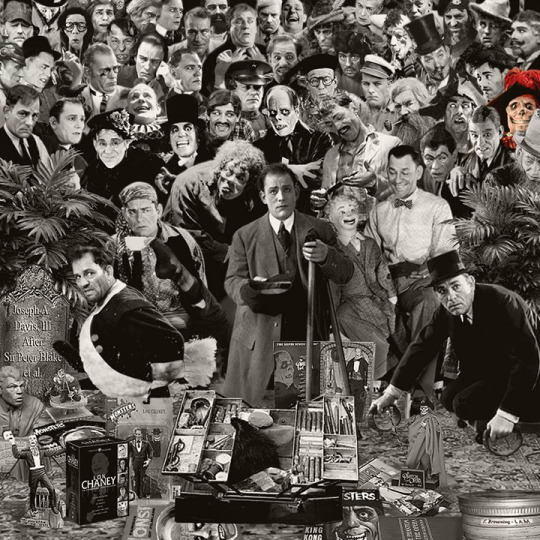
#lon chaney#lon chaney sr.#lon chaney senior#leonidas frank chaney#jann haworth#the man of a thousand faces
4 notes
·
View notes
Note
any shakespeare aus like Romeo and Juliet, Macbeth and so on?
okay i could only find
This Ain't No Shakespeare by KillTheDirector
"Two ice cream shops, both alike in dignity, in fair New York where we set our scene..."
The rivalry between Hydra-Freeze and SHIELD Sundaes was one of the most well known through out the amusement park. The romance between shift managers James "Bucky" Barnes and Steve "I'll punch you in the dick" Rogers was even more well known.
buuut there are quite a few fics that reference shakespeare in some way
Into the Lion's Mouth by reclusiveq
All Bucky wants to do is finish out his senior year at a new school without anymore trouble. But he apparently attracts trouble, and this time it goes by the name of Steve Rogers.
Like Lon Chaney by Sassaphrass
Bucky's knows two things without a doubt to be true: he's a monster- a wolf-man, and Steve is good. Too good for a monster like him, but, he'll stay as long as Steve let's him.
Of course, secrets have a way of coming out in the worst possible ways.
Never Doubt I Love by stripyjamjar
In the midst of war, Steve confesses in a quiet sunlit church in Hungary. Also featuring sleepy Bucky Barnes and Monty Falsworth being thrown in a lake.
Oh, and some casual Shakespeare.
The Play's the Thing by toli-a (togina)
Steve had heard there were HYDRA minions lurking in the Shakespeare troupe. Infiltrating the play might not have been his brightest idea.
49 notes
·
View notes
Photo
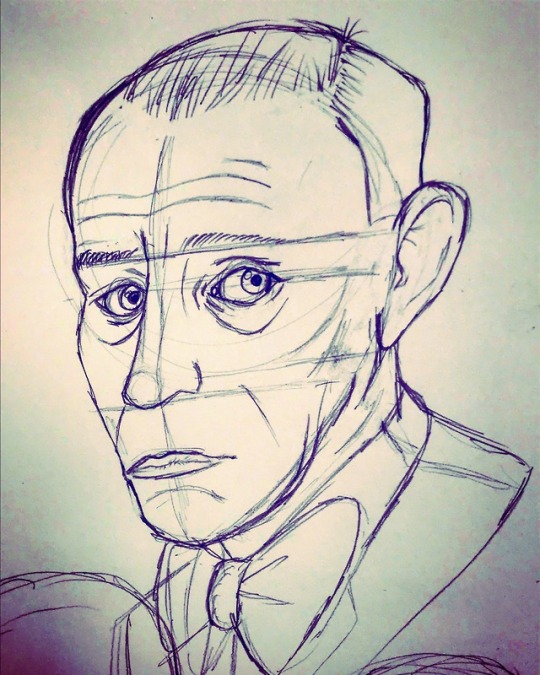
@theheadlessgroom Thought you would appreciate a Lon Chaney practice sketch I did for an art project
#Lon Chaney#lon chaney senior#thefuriousmagician art#((not that good at realism; you can see my style leaking thru#black and white movies
5 notes
·
View notes
Text
Comic Review: Dracula

While recreating a deceased celebrity via CGI or hologram technology often feels exploitative, doing so in comic book form is far more palatable. Legendary Comics' new Dracula graphic novel adapts Bram Stoker's influential 1897 novel with Bela Lugosi - who famously portrayed the titular character in Universal's classic 1931 film adaptation - as the Count. It was done in full cooperation with Lugosi's estate, which is particularly interesting since the landmark Lugosi v. Universal Studios suit paved the way for the Celebrity Rights Act.
Lugosi was a prolific actor, with over 100 film credits to his name, but his portrayal of Dracula left an indelible mark on pop culture; the actor's distinctive Hungarian accent has even become synonymous with the character. Similarly, Stoker was an accomplished writer but only experienced mild success during his lifetime. The two horror titans are forever found by Dracula, and the graphic novel pays tribute to Lugosi's legacy while staying true to Stoker's novel.
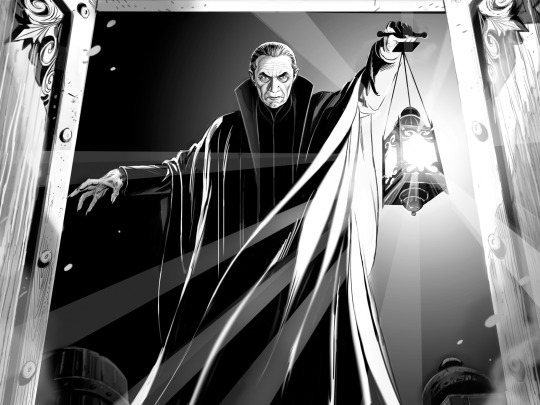
Tasked with adapting Stoker's masterpiece is Robert Napton, Senior Vice President of Publishing at Legendary Comics. El Garing's stark, black-and-white illustrations bring the words to life, with art direction and additional art by Kerry Gammill. Richard Starkings and Tyler Smith handle lettering and design. Lugosi's son, Bela G. Lugosi, and granddaughter, Lynne Lugosi Sparks, serve as executive consultants to ensure the actor's estate is properly handled, but it's apparent from the high quality of the work throughout the book that Lugosi was in caring hands.
The hardcover tome begins with an introduction by Lugosi Sparks. It serves as a mini biography and also explains how the graphic novel came to be, from Gammill planting the seed for a comic in 1999 to a serendipitous run-in with Napton getting the ball rolling before work officially began in 2016. Stoker's great grand-nephew, Dacre Stoker, provides an afterword in which he digs into the author's confluence of influences that likely inspired his writing of Dracula.
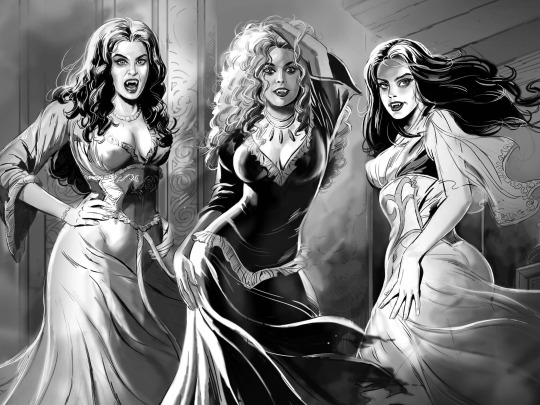
Broken up into seven chapters, the 200-page graphic novel tells the tale of the ancient Transylvanian vampire's move to England to spread his curse before being confronted by his archenemy, Professor Abraham Van Helsing, in a prototypical battle between good and evil. Like the novel, the story is told in an epistolary format; largely framed as journal entries from Jonathan Harker, who first discovers that the Count is a vampire and becomes his prisoner, and his fiance, Mina Murray, who is bitten by Dracula.
The graphic novel brings to life all of the Gothic atmosphere and striking imagery from the book. From the goose bump-inducing, full-page reveal of Dracula that concludes the first chapter, Garing and Gammill perfectly capture Lugosi's suave likeness as the Count: his gleaming eyes, bushy brows, slicked-back hair, sinister scowl, and piercing fangs. Unbeholden to censors, budgetary restrictions, or technological limitations, the comic showcases both the carnage and the fantastic elements of the novel. While never gratuitous, it's more graphic than the 1931 film.
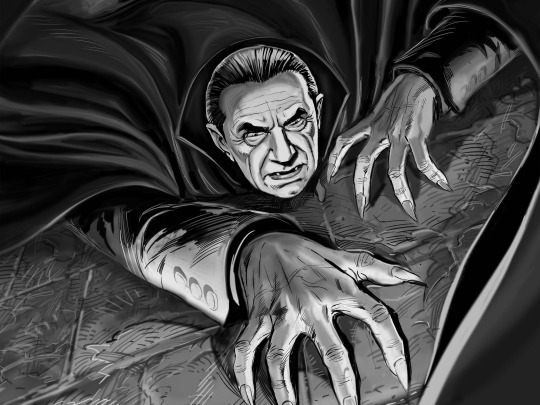
Dracula is an ambitious experiment that yields fruitful results. I would love to see Legendary Comics give similar treatments to other actors known for horror adaptations, like Boris Karloff in Mary Shelley's Frankenstein, Lon Chaney in Gaston Leroux's The Phantom of the Opera, Claude Rains in H. G. Wells' The Invisible Man, or Vincent Price in any of Edgar Allan Poe's works. The fascinating approach introduces comic readers to classic monsters, influential literature, and iconic performances all while giving longtime fans a fresh but faithful perspective on the well-trodden material.
Dracula is available now via Legendary comics.
#dracula#bela lugosi#bram stoker#bram stoker's dracula#horror#universal monsters#horror comics#book#review#article#gift#robert napton#kerry gammill#el garing#dracula 1931#dacre stoker
37 notes
·
View notes
Photo
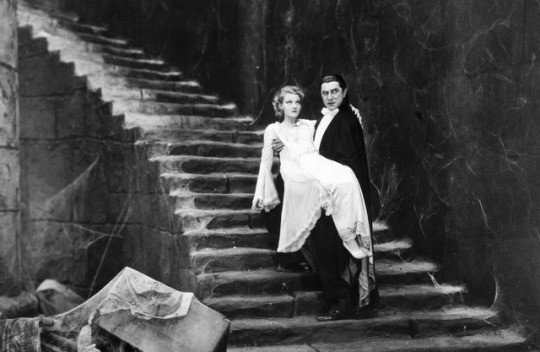
Movie Odyssey Retrospective
Dracula (1931 English-language version)
The 1920s had been an ideal breeding ground for horror films in the West. As cinematic technology improved and daring directors unleashed their magic on nitrate film, audiences found themselves terrorized by titles like Nosferatu (1922, Germany), The Phantom of the Opera (1925), and The Unknown (1927). With the introduction of synchronized sound, it was only a matter of time before someone took the genre to the talkies. Tod Browning (frequent collaborator with Lon Chaney, Sr., including The Unknown) would be that director, and the first horror masterpiece after the silent era would be Dracula, based on the 1924 stage play Dracula (itself based on the classic Bram Stoker novel of the same name). Universal Studios – a major studio but not yet considered in the same class of Metro-Goldwyn-Mayer, Paramount, 20th Century Fox, and Warner Bros. at that time – had been considered specialists in horror and further burnished that reputation here. Hungarian-American Béla Lugosi became an overnight sensation, and since 1931 he has always been associated with black flowing capes, a badass accent, and blood-sucking.
Before a brief synopsis, it should be noted that there is a Spanish-language version of this film, Drácula, directed by George Melford and starring Carlos Villarías as the title character. That film, also released by Universal, came at a time when – during the early years of synchronized sound movies – studios frequently released non-English language versions of their movies (almost always European languages like French, German, Hungarian, Italian, Swedish; a burgeoning, but bankruptcy-prone market for films catering to the United States’ numerous ethnicities existed, too). Thought lost to time, Drácula resurfaced in the 1970s and has been restored for public consumption. A third version – a silent film – was released to theaters that had not updated their technology yet. As should be obvious, this write-up on Dracula will be on the English-language version with synchronized sound.
On Walpurgis Night somewhere in the Carpathian Mountains of Transylvania (present-day Romania), Englishman Renfield (Dwight Frye) is traveling by carriage to reach his client, Count Dracula’s (Lugosi) estate. Count Dracula has expressed his interest in an abbey outside of London. Villagers, warning of the spirit of Nosferatu, are fearful that the Count is a vampire, but Renfield dismisses those concerns. Renfield arrives at the castle, stunned at the immensity of the place and the appearance of a cloaked, slick-haired figure gracefully, slowly making his way down an immense, cobwebbed staircase. After bidding Renfield welcome, something can be heard howling outside.
“Listen to them. Children of the night. What music they make.”
Renfield becomes Dracula’s first victim and servant – groveling, maniacal, and violent – as the plot shifts to England and characters like Professor Van Helsing (Edward Van Sloan), sanitarium Dr. Seward (Herbert Bunston), his daughter Mina (Helen Chandler), Mina’s fiancée John Harker (David Manners), and Mina’s friend Lucy Weston (Frances Dade) begin investigating their newest acquaintance.
As the vampire Count Orlok in Nosferatu (itself an unauthorized version of Dracula), Max Schreck relied on his physical acting and makeup to frighten audiences. As Count Dracula in this film, Lugosi has a powerful weapon not afforded to Schreck: the sound of his voice. Born in 1882, Lugosi, having appeared in 1927 as Count Dracula in the stage play this movie is based on, arrived in the United States from Hungary in 1920. In that interim, Lugosi became fluent in English (this is disputed, but even if he had to learn his lines phonetically, the results were worth it) yet retained a thick Hungarian accent that prevented him from having a more prolific, diverse movie career. Nevertheless, in Dracula, his dialogue delivery – deliberate, deceptive, sometimes pausing for no apparent reason near the end of sentences – is incredible. Where Schreck’s Orlok angled for removing any semblance of humanity, Lugosi’s Dracula (which, on the basis of subsequent cultural references, has become the preferred prototype on which to create a vampiric character) is sophisticated, in touch with his humanity, all while retaining a threatening sexuality – “I never drink… wine,” he says. To put that in terms of a scenario, meeting Lugosi’s Dracula for dinner in any place outside of his castle might leave you charmed by the Count and just comfortable enough to eat and drink in his presence. That is, until Dracula feeds on you.
Universal did not see Lugosi as their first-choice Dracula; instead, that went to the senior Lon Chaney (1924′s He Who Gets Slapped, The Phantom of the Opera). Chaney died prior to production and, despite Universal’s preference for Paul Muni, relented when Lugosi lobbied relentlessly and said he was willing to accept an exiguous salary of $3,500 (~$56,000 in 2017′s USD). Lugosi declared bankruptcy the year after the film’s release. Having turned down the title role in Frankenstein (1931), Lugosi plodded through years of typecasting as suave horror villains and a British ban on horror films in the mid-1930s. He never became as established a movie star as fellow Universal Monsters star Boris Karloff, and played Count Dracula only twice – the second time in Abbott and Costello Meet Frankenstein (1948).
Alongside a bevy of forgettable performers, only one other actor stands out. That is Dwight Frye (who would also play Fritz in Frankenstein later that year) as the realtor-turned-slave Renfield. His performance, nowadays, might be dismissed as a relic of the worst of silent-era filmmaking that seems anachronistic even in 1931, but it works. Whether Frye swings into entertaining campiness or unmitigated insanity, he serves the film wonderfully. With eyes wide, veins pulsing from his neck, and not giving a shit about what people think of his behavior, Frye’s Renfield is unpredictable, unstable, and possesses an unsettling laugh – it is not the stereotypical villainous belly/diaphragm laugh – halfway between a sneer and a chuckle. It is not exactly something you want to hear in the darkness.
Director Tod Browning – an expert in horror films – assembles a team of craftspersons of envying pedigree. Production designers Herman Rosse and John Hoffman and art director Charles D. Hall (1930′s All Quiet on the Western Front, Frankenstein) outdo themselves with Dracula’s castle. It is everything you want from a decrepit fortress – cobwebs (one eighteen-foot spiderweb was created by rubber cement shot out of a rotary machine gun), an enormous fireplace (one fire made so much noise that the primitive microphones then being used picked up that sound rather than the dialogue; production halted as the fire winded down) ruined windows and columns, and tangled vines intruding from the outside. The enormity of the set lands with chilling impact, assisted with the costume design by Ed Ware and Vera West and cinematography by Karl Freund (1927′s Metropolis, 1937′s The Good Earth, I Love Lucy) inspired by German expressionism – a silent film-era movement which emphasized exaggerated geometries, shadows, and high-contrast lights and darks. Freund’s camera is often static but, unlike many films the early 1930s, slowly floats across the set when needed. This creates an impending sense of terror, lending Dracula a thick atmosphere that has kept it watchable even though the movie itself may no longer be scary to most. However, this focus on the production design is mostly abandoned after twenty-five minutes as Dracula finds himself in London. Lugosi and Frye’s performances grab the film by the scruff, and further solidified themselves into Hollywood lore.
The sets themselves impressed Universal’s art department and directorial contractees so much that they remained standing for at least a decade longer for subsequent films for the studio; the finale of Sherlock Holmes and the Voice of Terror (1942) holding its finale within what used to be Dracula’s walls, for example. These same sets also appeared in the Spanish-language Drácula –when the English-language production completed its shooting during the daytime, the Spanish-language production commenced at night using much of the same resources. The cast and crew of the Spanish-language production might even have had an advantage, as they had access to the English-language Dracula’s dailies/rushes (raw, unedited footage of the day’s shooting on a movie), to tinker with their own performances and handiwork.
Other than Tchaikovsky’s most famous theme from his ballet Swan Lake playing over the opening credits and a brief snippet of Wagner and Schubert, there is zero music in Dracula. In scenes as Dracula is approaching someone with ill intentions, this increases the dread. In transition scenes where the audience is reading the text of some publication or when characters are traveling, this might not work with impatient viewers. This almost-complete lack of music is because – with synchronized sound introduced just four years earlier – filmmakers believed that movie audiences could not accept music in a film unless there was a source of music within the film (diegetic music; one of those instances is when an orchestral performance is featured in Dracula). Considering that silent films were never truly silent – movie theaters during the time had resident musicians (typically pianists, organists, or small ensembles) – and that movie music has become a genre all its own, that idea might seem quaint to modern audiences. Watch enough post-Jazz Singer 1920s and early 1930s movies and one will notice that lack of music is widespread.
In other aural developments, depending on the quality of the print that you watch, a crackling image noise may be heard throughout the film. That is due to the age of the film print and the quality of the sound recording available in 1931; the newest restorations of Dracula should minimize the sound.
Though a relic of early Hollywood horror, it is a film energized by a star-making performance from Lugosi, which has since altered audience conceptions of what a vampire looks like, talks like, moves like. Okay, we never see Dracula’s blood-sucking fangs, but credit Lugosi, Browning, and screenwriter Garrett Fort for devising a character that is essentially the origin of anything that even references vampirism.
Dracula shows its age as it approaches its ninetieth anniversary. Wooden acting from almost all of the supporting cast, its rough editing, and pacing issues may not be accommodating for those accustomed to older movies and are watching the film without knowing the limits of cinematic technology in 1931 (again, Dracula may have terrified viewers upon release, but it is no longer “scary” in the modern sense). It is an essential piece of the horror genre, as well as cinema. The dedication to which those behind the camera applied to this film is remarkable, diffusing a frightful feeling that could only have been produced in its own time.
My rating: 9/10
^ Based on my personal imdb rating. My interpretation of that ratings system can be found here.
This is the tenth Movie Odyssey Retrospective. Movie Odyssey Retrospectives are write-ups on films I had seen in their entirety before this blog’s creation or films I failed to give a full-length write-up to following the blog’s creation. Previous Retrospectives include A Boy Named Charlie Brown (1969), Harry Potter and the Sorcerer’s Stone (2001), and The Wizard of Oz (1939).
#Dracula#Tod Browning#Bela Lugosi#Helen Chandler#David Manners#Dwight Frye#Edward Van Sloan#Herbert Bunston#Frances Dade#Carla Laemmle#Garrett Fort#Karl Freund#Charles D. Hall#Herman Rosse#John Hoffman#Ed Ware#Vera West#TCM#My Movie Odyssey
1 note
·
View note
Photo
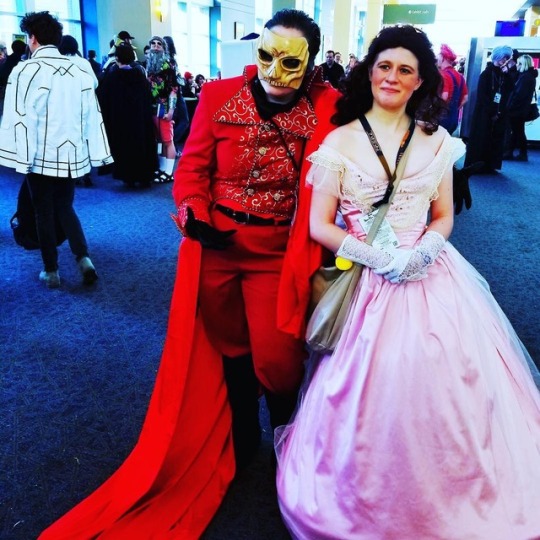
Naka-Kon 2019, Day 2 🎉 Looked for these two to tag them. Couldn’t find them. If anyone knows, let me know. 🤗 I make no secret of my love for all things Phantom of the Opera. It is a passion that dates back to the senior Lon Chaney and my childhood. And I love the Masque of the Red Death scene from any version. These two captured the power of one such adaptation perfectly. Blown away. Simply blown away. 🤟🤗🤟🤗 #ohawclan #acemarken #nakakon2019 #reddeathcosplay #thephantomoftheopera #phantomoftheopera #andrewllyodwebber #masqueofthereddeath #christinedaaecosplay #christinedaae https://www.instagram.com/p/BviDLLPH69q/?utm_source=ig_tumblr_share&igshid=16neng9cb95i8
#ohawclan#acemarken#nakakon2019#reddeathcosplay#thephantomoftheopera#phantomoftheopera#andrewllyodwebber#masqueofthereddeath#christinedaaecosplay#christinedaae
0 notes